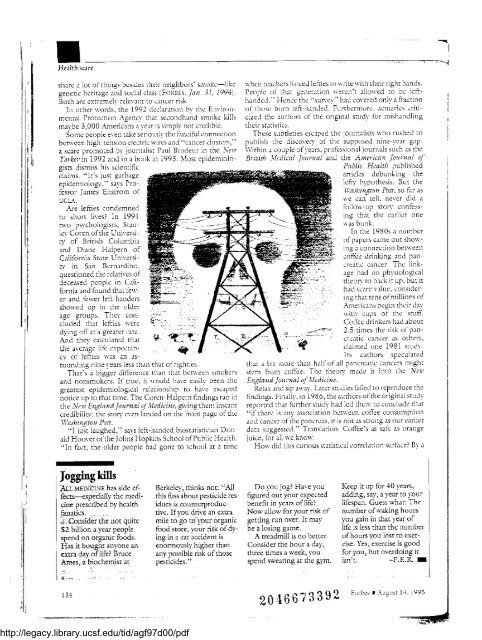How business, doctors and journalists prey on your food anxieties I
How business, doctors and journalists prey on your food anxieties I
How business, doctors and journalists prey on your food anxieties I
Create successful ePaper yourself
Turn your PDF publications into a flip-book with our unique Google optimized e-Paper software.
I<br />
∎<br />
Health scare<br />
share a lot of things besides their neighbors' smoke-like<br />
genetic heritage <str<strong>on</strong>g>and</str<strong>on</strong>g> social class (Fo1utES, Jan . 31, 1994) .<br />
Both are extremehrelevant to cancer rsk-<br />
In other %,nrds, the 1992 declarati<strong>on</strong> bthe Emir<strong>on</strong>menral<br />
Protecti<strong>on</strong> Agency that sec<strong>on</strong>dh<str<strong>on</strong>g>and</str<strong>on</strong>g> smoke kills<br />
mavbe 3,000 :lmericans avear is simplv nor credible .<br />
Some people even take serious,y the PanciPul c<strong>on</strong>neci<strong>on</strong><br />
between high-tensi<strong>on</strong> electric wires <str<strong>on</strong>g>and</str<strong>on</strong>g> "cancer clusters,"<br />
a scare promoted by journalist Paul Brodeur in the New<br />
Yorherin 1992 <str<strong>on</strong>g>and</str<strong>on</strong>g> in a book in 1993 . Most epidemiologists<br />
dismiss his scientific<br />
claims . "It's just garbage<br />
epidemiology," says Professor<br />
James Enstrom of<br />
UCL~1 .<br />
2.re lefties c<strong>on</strong>demned<br />
to short liNes? In 1991<br />
two psachologists, Stanlev<br />
Coren of the University<br />
of British Columbia<br />
<str<strong>on</strong>g>and</str<strong>on</strong>g> Diane Halpern of<br />
California State Universitv<br />
in San Bernardino,<br />
questi<strong>on</strong>ed the relatives of<br />
deceased people in California<br />
<str<strong>on</strong>g>and</str<strong>on</strong>g> found that Pewer<br />
<str<strong>on</strong>g>and</str<strong>on</strong>g> fewer left-h<str<strong>on</strong>g>and</str<strong>on</strong>g>ers<br />
showed uo in ehe older<br />
age groups . They corr<br />
cluded that lefties were<br />
dving off at a greater i-ate .<br />
And they caladated that<br />
the average life expectanev<br />
of lefties was an astounding<br />
nine years less than that of righties .<br />
That's a bigger difference than that berneen smokers<br />
<str<strong>on</strong>g>and</str<strong>on</strong>g> n<strong>on</strong>smokers . If true, it would have easihbeen the<br />
greatest epidemiological relati<strong>on</strong>ship to hase escaped<br />
notice up to that time . The Coren-Halpern findings ran in<br />
the New Era171<str<strong>on</strong>g>and</str<strong>on</strong>g> Journal aflledicine, giving them instant<br />
credibiliry ; the story even l<str<strong>on</strong>g>and</str<strong>on</strong>g>ed <strong>on</strong> the fr<strong>on</strong>t page of the<br />
Wcuhexgtan Past .<br />
"I just laughed," says left-h<str<strong>on</strong>g>and</str<strong>on</strong>g>ed biostatistician D<strong>on</strong>ald<br />
Hoover of the Johns Hopkins School of Public Health .<br />
"In fact, the older people had g<strong>on</strong>e to school at a time<br />
sshen teachers forced lefties to ssrite with their right h<str<strong>on</strong>g>and</str<strong>on</strong>g>s .<br />
People of that generati<strong>on</strong> ~seren't allowed to be lefth<str<strong>on</strong>g>and</str<strong>on</strong>g>cd<br />
." Hence the °surev" had covered <strong>on</strong>lv a fracti<strong>on</strong><br />
of those born left-h<str<strong>on</strong>g>and</str<strong>on</strong>g>ed . Furthermure, actuaries criticized<br />
the authors of the origittal stud}' for mish<str<strong>on</strong>g>and</str<strong>on</strong>g>ling<br />
their statistics .<br />
These subtleties escaped the <str<strong>on</strong>g>journalists</str<strong>on</strong>g> whn rushed to<br />
publish the discovery of the supposed nine-vear gap .<br />
Within a couple of years, protessi<strong>on</strong>al journals such as the<br />
Britz`sh hledicnl Josr-nal <str<strong>on</strong>g>and</str<strong>on</strong>g> the American Journal of<br />
PrrGlic Health published<br />
articles debunking the<br />
leftV hypothesis . But the<br />
IS'ashin,gt<strong>on</strong> Post, so far as<br />
s~e can tell, never did a<br />
follo~~-up storv c<strong>on</strong>fessing<br />
that the earlicr <strong>on</strong>e<br />
ssas bunk .<br />
In the 1980s a number<br />
of papers came out sho«'-<br />
ing a c<strong>on</strong>necti<strong>on</strong> between<br />
coffee drinking <str<strong>on</strong>g>and</str<strong>on</strong>g> pam<br />
creatic cancer . The linkage<br />
had no physiological<br />
the<strong>on</strong>, to back it up, but it<br />
had scare value, c<strong>on</strong>siderine<br />
that tens of milli<strong>on</strong>s of<br />
Americans begin their dat<br />
with cups of rhe stut~~ .<br />
Coffee drinkers had about<br />
2 .5 times the risk of pancroatic<br />
cancer as otbers,<br />
claimed <strong>on</strong>e 1981 studv .<br />
Its authors speculated<br />
that a bit more than half of all pancreatic cancers might<br />
stem from coffee . The the<strong>on</strong>y made it into the Nem<br />
Engiaud Joru'sral af Mcdidne .<br />
Relax<str<strong>on</strong>g>and</str<strong>on</strong>g> sip awav . I .arer studies failed to reproduce the<br />
findings . Finally, in 1986, the authors of the origin°al study<br />
reported that further study had led them to c<strong>on</strong>clude that<br />
"if there is any associati<strong>on</strong> bctween coffee c<strong>on</strong>sumptiorn<br />
<str<strong>on</strong>g>and</str<strong>on</strong>g> cancer of[he pancreas, it is not as str<strong>on</strong>g as our earlier<br />
data suggested ." Translati<strong>on</strong> : Coffee's as safe as orange<br />
juice, for all «'e know .<br />
<str<strong>on</strong>g>How</str<strong>on</strong>g> did this curious statistical correlati<strong>on</strong> stuface? By a<br />
jOgging kills<br />
A[ i ntEniCNE has side effects~sgecially<br />
the medicine<br />
prescribed by health<br />
fanatics .<br />
C<strong>on</strong>sider the not quite<br />
$2 bitli<strong>on</strong> a year people<br />
spend <strong>on</strong> organic <strong>food</strong>s .<br />
Has it bought any<strong>on</strong>e an<br />
extra day oflife? Bruce<br />
Ames, a biochemist at<br />
Berkeley, thinks not : "All<br />
this fuss about pesticide residues<br />
is counterproductive<br />
. If you drive an extra<br />
mile to go to <strong>your</strong> organic<br />
<strong>food</strong> store, <strong>your</strong> risk of dying<br />
in a car accident is<br />
enormously higher than<br />
any possible risk of those<br />
pesticides ."<br />
Do you jog? Have you<br />
figured out <strong>your</strong> expected<br />
benefit in years of life?<br />
Now allow for <strong>your</strong> risk of<br />
getting run over. It may<br />
be a losing game .<br />
A treadmill is no better .<br />
C<strong>on</strong>sider the hour a day,<br />
three times a week, you<br />
spend sweating at the gym .<br />
Keep it up for 40 years,<br />
adding, say, a year to <strong>your</strong><br />
lifespan . Guess what : The<br />
number of waking hours<br />
you gain in that year of<br />
life is less than the number<br />
of hours you lost to exercise<br />
. Yes, exercise is good<br />
for you, but overdoing it<br />
isn't. -P .E .R. M<br />
134<br />
20466 7 3392 F,rbe, . A ,g .,stly .f9y,<br />
http://legacy.library.ucsf.edu/tid/agf97d00/pdf

















